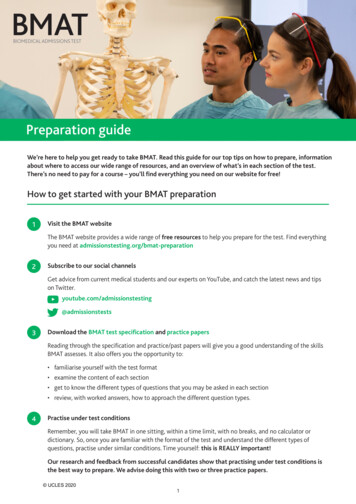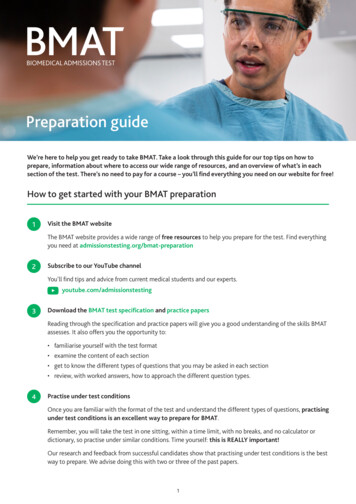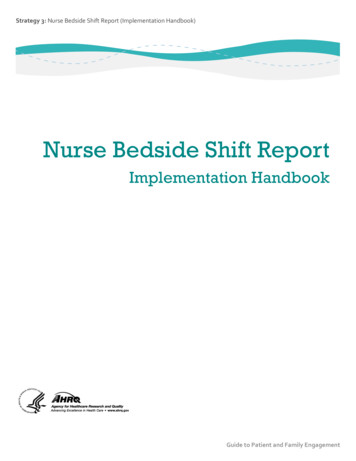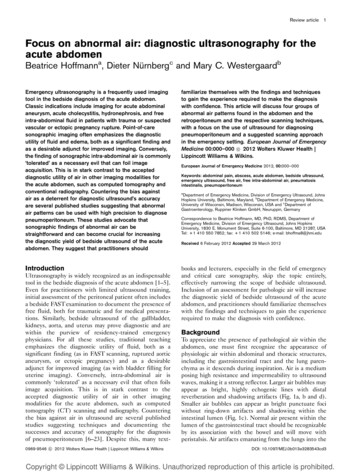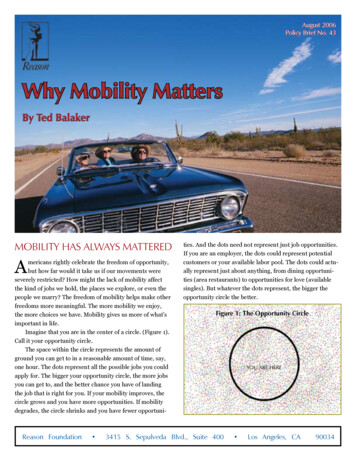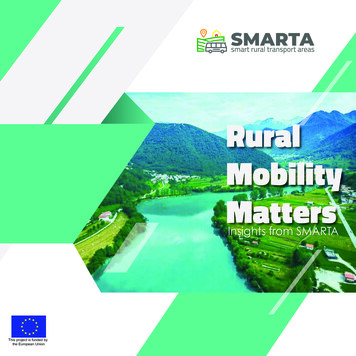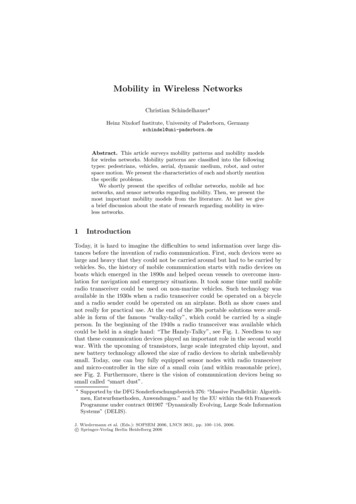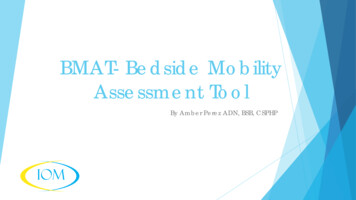
Transcription
BMAT- Bedside MobilityAssessment ToolBy Amber Perez ADN, BSB, CSPHP
What is BMAT BMAT was developed during a multi-hospital SPHM implementationBMAT was developed to answer the question; “What type of equipmentdo I use with my patient?” & “What is my patients level of mobility?”BMAT is a validated assessment for SPHM and a functional mobilityassessmentThe BMAT may reduce witnessed falls and promote early mobilitypractices.The BMAT is a Nursing tool that recommends equipment for safe patienttransfers and mobilityThe BMAT reduces variation in care related to the risk of patient handlingand falls
Learning Objectives Knowledge: RN will have the knowledge of the validated BedsideMobility Assessment Tool (BMAT), communicate patients’ mobilitystatus to care team, and assign the appropriate assistive equipment. Application: RN will be able to apply assessments in their currentcare delivery and assign a mobility status communicated to careteam, patient, and family members. Comprehension: RN will have the ability to quickly determine whichequipment to use for each type of task based on the assigned BMATlevel.
Essential Elements for Success Routine assessments performed- BMAT is recommended every shift. Apatients mobility level may change as he becomes more tiredthroughout the dayPlacing appropriate mobility level signage outside the patient roomcommunication of SPHM needsAlert staff of patient mobility needs.Reassessment with change of condition or concerns from PT/OT, CNA orPCTIntegrate BMAT into your daily head to toe assessment
Room signs There are a variety of optionsfor making your own roomsigns, printing themprofessionally, or purchasingmagnets, flags or other visualindicators. The visual indicator is anessential element to thesuccess of implementing thetool. Signs provides clearcommunication about apatients abilities to allcaregivers.
Mobility AssessmentThe results of the mobility assessment will help you determine thetype of equipment neededBMAT LEVELDefinitionMobility Level 1Dependent patient. This patientis unable to move or transfer selfMobility Level 2Moderately dependent patient.This patient can come to a sittingposition but cannot stand ortransferMobility Level 3Minimal assistance required. Thispatient can bear weight and mayrequire assistive devices.Mobility Level 4Independent. This patient canmove and transfer self andrequires no patient handling asst.
Mobility Assessment Level 1Determine baseline assistiveequipment used at home.Sit and Shake From a semi-reclinedposition, ask your patient tosit upright and rotate to aseated position at the sideof the bed. Ask patient to reach acrossmidline to shake your hand.
Sit and ShakeThe SIT portion ofthe test will helpyou determinewhether yourpatient hasadequate balanceand core strengthfor sitting.
Sit and ShakeThe SHAKE portion of theassessment will test a patientsupper body strength andproprioception or or spatialorientation and awareness ofbody in space.Shake for: Assessing Balanceproprioception Fall Prevention (safety beforestanding).
Mobility Level 1
Assessment Level 2Stretch and Point Ask patient to extend legforward until it is straightat the knee.Ask the patient to pointand flex foot/toes.Repeat with other leg ifappropriate.*Remember, if the patient has unilateralrestrictions or weakness for examplefrom orthopedic restrictions orweakness after CVA, it is appropriate tomeasure only one leg.
Stretch and PointThe STRETCH portion of the assessmenttests for the minimal quad strengthneeded to stand.The patient must be able to extendhis leg independently and repeatwith both legs. Exceptions includethe following patients: Amputee with prosthetics. Amputee with one leg weightbearing ability. Orthopedic surgical patients withone leg weight bearing ability. Other conditions limiting weightbearing ONLY to one side.
Stretch and PointThe POINT portion of the assessment testsfor conditions such as foot dropYour patient must be able to point and flexhis foot on the foot or feet he intends toweight bear on.Exceptions: If your patient is unable to perform thisstep AND he has already been assessedby PT, you may proceed with the stepsof the assessment if walking aid isprescribed or it is recommended byPT/OT. If no PT assessment is completeddiscussion with physician and considerrequesting a PT consult.
Mobility Level 2
Assessment Level 3 If needed, obtain assistiveequipment (walker, gait belt,cane).Stand Ask your patient to elevate off thebed or chair using an assistivedevice if needed.Patient should be able to raisebuttocks off bed and hold for acount of five.
StandThe STAND portion ofthe assessment teststhe patient’s ability tocome to a standingposition and maintainstanding for 5 seconds.Provide assistive devicesuch as walker, cane, orcrutches if needed.Remember to ask whetherthe patient uses an assistivedevice at home.
Mobility Level 3
Mobility Assessment Level 4Walk Ask your patient tomarch in place atbedside.Then ask patient toadvance step andreturn each foot.
WalkThe WALK portion of the assessment tests forsteady standing and walking.Ensure that your patient is stable on his feetbefore you ask him to take a step.Some conditions cause taking stepsforward and backward difficult. Ensuresafety and guide the patient back tothe edge of bed if your patientappears unstable.
Assessment Level 4FAIL Mobility Level 3.PASS Mobility Level 4CALLDON’TFALL
BMAT and Therapy Services Therapy evaluations are more complex and intended to helprehabilitate the patientThe BMAT is a nursing toolCollaborate with therapy services to create a plan that includes thetherapy goals and SPHM.
Scenarios Mr. Sing is an 87 year old CVA patient with R-sided weakness. Mr. Sing isable to come to the edge of bed using the hand rail to sit up. He canshake hands on the unaffected side. Mr. Sing is able to stretch and pointhis left leg only and he can stand up for 5 seconds. Mr. Sing is unable totake any steps or march in place.What mobility level is Mr. Sing? MOBILITY LEVEL 3 What interventions are appropriate for transfers out of bed?
MOBILITY LEVEL 3 Interventions Non-powered stand aids Walker Cane Crutches Stand pivot transfer to WC
Scenario 56 year old Mrs. Hansen is an ICU patient recovering from a MVA. Shesustained a TBI and multiple wounds and skeletal fractures. Mrs. Hansenis on a ventilator and IV sedation and pain interventions. Mrs. Hansen isnon-responsive, flaccid and unable to participate in any movement. What mobility level is Mrs. Hansen? MOBILITY LEVEL 1 What interventions are appropriate for moving Mrs. Hansen?
MOBILITY LEVEL 1 Interventions Safe handling sheet Mobile lift and sling Friction reducing devices Air assisted lateral transfer Limb slings
Scenario 66 year old Mr. Waters is a patient recovering from a TKA of his leftknee. He has no weight bearing restrictions and is post op day 1. Thecatheter has been removed and hospital protocols require toileting on acommode or toiled to improve mobility. Upon assessment, Mr. Waters isable to come to a sitting position, shake hands and maintain balanceand stretch and point both limbs. Mr. Waters is experiencing great painand unable to come to a standing position on his own, but reports thathe needs to use the bathroom. What mobility level is Mr. Waters? MOBILITY LEVEL 2 What interventions are appropriate for Mr. Waters safe transfer?
MOBILITY LEVEL 2 Interventions Identify the mobility level on the signage Sit to stand aid
Scenario Mr. Williams is a 54 year old male recovering from an appendectomypost op day one. Mr. Williams is able to sit up to the edge of bed, shakehands, stretch and point, and stand. Mr. Williams is able to march inplace, take forward and backward steps. What mobility level is Mr. Williams? MOBILITY LEVEL 4 What interventions are appropriate for Mr. Williams safety?
Mobility Level 4 Interventions Call don’t fallAssess patient understanding of safetyawarenessAssess patient environment for safety(lighting, obstructions, non-slip socks)Educate patient regarding risks of fallingand signs of instability, remind patient toinform staff if he feels a change in balanceand stability
Scenario Mrs. Narin is a 72 year old recovering from pneumonia and receiving IVantibiotics. Mrs. Narin is not your patient and no mobility level is postedoutside her door. Mrs. Narin rang her call light and is asking forassistance to the restroom. You find Mrs. Narin sitting up in a chair at thebedside, sitting up and not leaning back in the chair. How do you assessMrs. Narin’s level of mobility? Begin the assessment where she is. Mrs. Narin demonstrates corestrength, sitting unassisted in a chair, not leaning on the chair for support.Start with shake, then proceed with assessment.
Scenario Mr. Allen is a 53 year old recovering from a MVA, he has healing ribfractures and is expecting to discharge tomorrow. You walk by his roomand see him standing at the bedside, holding onto the rail. No mobilitylevel is posted. How do you assess his mobility? The patient demonstrates the ability to come to a standing position,start with asking the patient to sit at the bedside and cross midline toshake your hand, then proceed directly to standing the patient at thebedside facing away from the bed with his thighs touching the bedbehind him. Ask the patient if he can let go of the rail and maintainstanding, if he shows stability, continue with assessment level 4.
Return Demonstrate .Time to TEACHthe B.M.A.T.
Teaching BMAT Demonstration Return Demonstration HANDS ON! Lets Practice .
BMAT is a validated assessment for SPHM and a functional mobility assessment The BMAT may reduce witnessed falls and promote early mobility practices. The BMAT is a Nursing tool that recommends equipment for safe patient transfers and mobility The BMAT reduces variation in care related to the risk of patient handling and fallsFile Size: 2MBPage Count: 36

